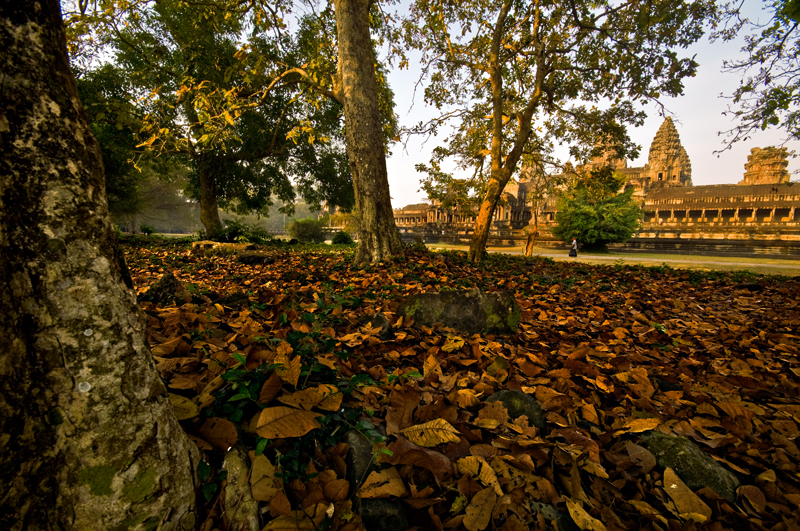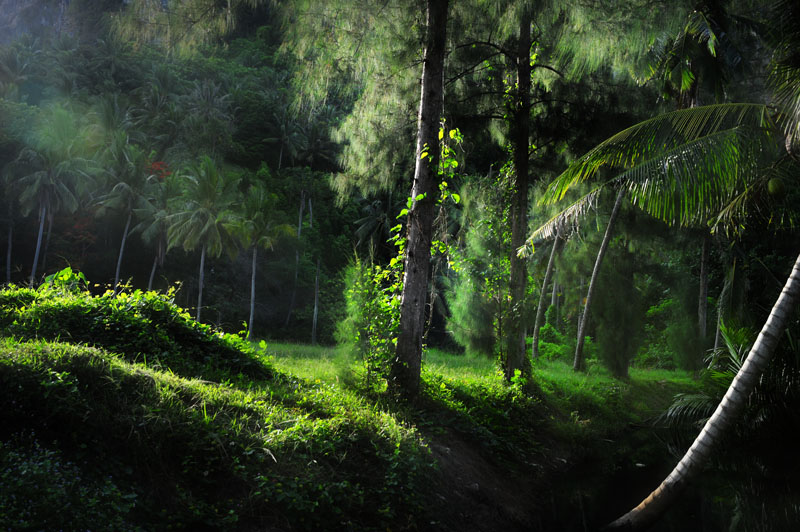Like everything in photography, shooting in color is a decision. That sounds weird, right? After all, the world is in Technicolor and we can’t really turn all the color off.
Color has emotional content. We use it a lot in the ways we express our feelings. “Red as a beet” for both embarrassment and anger. “Blue” when we’re sad. “Green with envy.” Our perceptions of color reach far beyond just what color something is. We can add impact to a photo when we use color effectively.
Cool colors around a tropical forest. Copyright Aloha Lavina.
Some colors are cool—the blue-green part of the color spectrum. These colors are usually soothing. Photos that are mostly blue or green, such as this photo of vegetation around a beach in Krabi, Thailand, exude a sense of calm. The second photo, of a farmer walking across a rice field in Vietnam, is mostly green, and the blue shirt of the farmer gives the color palette in the photo unity. The yellow, although it should intrude on the cool color palette, instead punctuates the blue and green and it also helps give the photo a three dimensional feeling, acting as a gradient running from foreground to background.
Colors can add depth to a photo. Copyright Aloha Lavina.
The other end of the spectrum—the red-yellow part, are the warm colors. Reds, yellows, oranges are fiery, aggressive colors and we associate them with like feelings. This photo of a swami in Rajasthan, India, is full of red and yellow. The walls, the clothing of the swami, even the ground, all have reds in them. I think this image works because all the elements in it contain similar hues. This harmony then allows the content of the image to pop out—the humor in the pose of the swami, and the self-deprecating smile on his face, playing with the photographer and the situation.
Red is brazen and more assertive. Copyright Aloha Lavina.
A sense of harmony in this shot from Siem Reap comes from the narrow color palette. The browns and yellows give the photo unity, and since everything is golden from the early morning light, even the green leaves in the photo are tinged with yellow.

A limited color palette helps harmonize an image. Copyright Aloha Lavina.
But we can’t always photograph still objects, such as Angkor Wat and fallen leaves. A lot of photography is of people. One of the most used tricks of shooting travel portraits is to find a great background, wait until someone interesting walks past it, and shoot. Usually this strategy produces some gems. After finding this wonderfully colorful wall in Vietnam, I waited and sure enough, a girl in the traditional ao dai dress walks by. Click. Now I look at this photo and think, would it work better as a black and white photo? The clash between the purple tinge on the girl’s dress and the red, yellow and green of the wall might be distracting and does not add to the photo. Sometimes, when the most compelling elements in a photo are lines or shapes, it works better as a monochrome image.
Making a color image is a matter of decisions the photographer makes. Since the goal of capturing an image is to create order out of chaos, to somehow arrange the elements of a scene into a harmonious design, we can’t ignore the fact that there are ways to use color in achieving an image.








5 Comments
Excellent post. I enjoyed reading what you had to share. This is one of the things I’m currently working on. I’ll try out to see how I can be more selective when I use color.
Good, nice to learn what to do with colors ..
One further distinction is the saturation of all colors, some colors or just one color. You can increase OR decrease any of these to project your ideas in any image. Landscape photographers often raise the saturation on all colors to simulate the effect of Velvia film. Some will drop the overall saturation to simulate older films that were not as sensitive to color. Some will desaturate the colors to B&W and then tone the whole photo with one color similar to sepia, but you can use any color for this. Many choices that can only be decided by the artist (photographer) to arrive at his/her vision of the image.